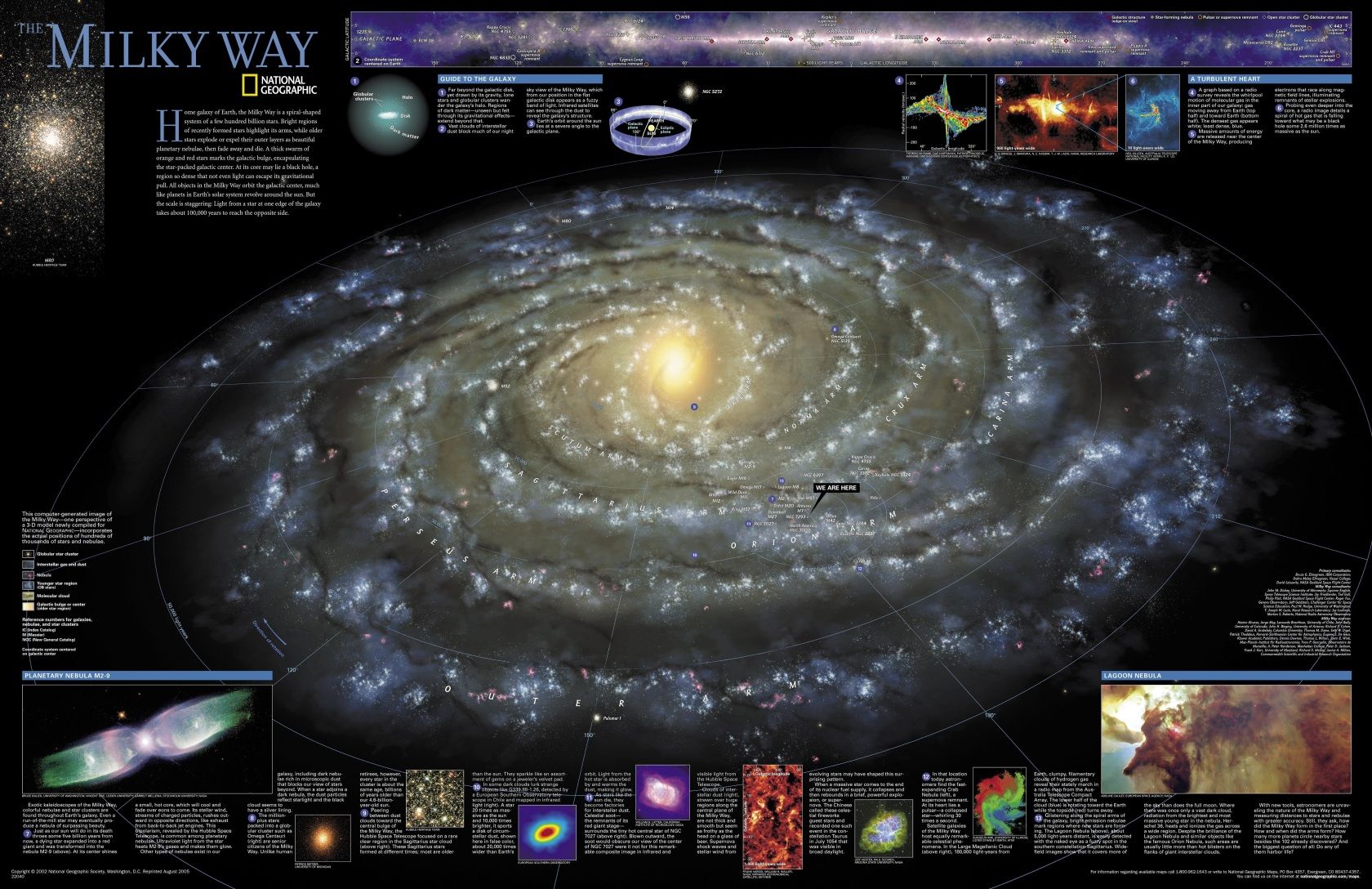银河星系(古称银河、天河、星河、天汉、银汉等)[18],是一个包含太阳系 [19]的棒旋星系。直径介于100,000光年[20]至180,000光年[21]。估计拥有1,000亿至4,000亿颗恒星[22][23],并可能有1,000亿颗行星[24][25]。太阳系距离银河中心约26,000光年,在有着浓密气体和尘埃,被称为猎户臂的螺旋臂的内侧边缘。在太阳的位置,公转周期大约是2亿4,000万年[15]。从地球看,因为是从盘状结构的内部向外观看,因此银河系呈现在天球上环绕一圈的带状。
银河系中最古老的恒星几乎和宇宙本身一样古老,因此可能是在大爆炸之后不久的黑暗时期形成的[9]。在10,000光年内的恒星形成核球,并有着一或多根棒从核球向外辐射。最中心处被标示为强烈的电波源,可能是个超大质量黑洞,被命名为人马座A*。在很大距离范围内的恒星和气体都以每秒大约220公里的速度在轨道上绕着银河中心运行。这种恒定的速度违反了开普勒动力学,因而认为银河系中有大量不会辐射或吸收电磁辐射的质量。这些质量被称为暗物质[26]。
银河系有几个卫星星系,它们都是本星系群的成员,并且是室女超星系团的一部分;而它又是组成拉尼亚凯亚超星系团的一部分[27][28]。整个银河系对银河系外的参考坐标系以大约每秒600公里的速度在移动。
Die Milchstraße, auch Galaxis, ist die Galaxie, in der sich das Sonnensystem mit der Erde befindet. Entsprechend ihrer Form als flache Scheibe, die aus Milliarden von Sternen besteht, ist die Milchstraße von der Erde aus als bandförmige Aufhellung am Nachthimmel sichtbar, die sich über 360° erstreckt. Ihrer Struktur nach zählt die Milchstraße zu den Balkenspiralgalaxien.
銀河系[6][7](ぎんがけい、the Galaxy)または天の川銀河[6][7](あまのがわぎんが、Milky Way Galaxy[7])は太陽系を含む銀河の名称である[7][8]。地球から見えるその帯状の姿は天の川と呼ばれる。
1000億の恒星が含まれる[7]棒渦巻銀河とされ[9]、局部銀河群に属している。
通常の銀河と同様、銀河系も数多くの恒星や星間ガスなどの天体の集まりで、全質量は太陽の1兆2600億倍[3]と見積もられている。そのうち可視光などの電磁波を放出している質量の合計は5.1%以下の643億太陽質量[3]で、質量の大部分は暗黒物質であると考えられている。中心付近には比較的古い恒星からなる密度の高いバルジを持ち、それを取り巻くように若い恒星や星間物質からなる直径約8万-10万光年のディスク(銀河円盤)がある。ディスク(銀河円盤)の厚さは中心部で約1万5000光年、周縁部で約1000光年で凸レンズ状の形状を持つ。ディスク(銀河円盤)の中には明るい星や散開星団、散光星雲などが多く見られる渦状腕が存在する。大きさを相対的に例えると、銀河系を直径130 kmに縮めた場合、太陽系は約2 mほどの大きさになる。バルジとディスクのさらに外側には約130個の球状星団などからなる直径約25万から40万光年の球形の銀河ハローが存在する。銀河系の中心は地球の立場から見るといて座の方向に約3万光年離れた所に位置しており、いて座Aという強い電波源がある。いて座Aの中心部(いて座A*)には超大質量ブラックホールが存在することが確実視されている。
天の川は天の赤道に対してはるか北のカシオペヤ座からはるか南のみなみじゅうじ座までの範囲に達している。このことから、地球の赤道面や軌道面である黄道面が銀河面に対して大きく傾いていることが分かる。また、天の川によって天球がほぼ同じ広さの二つの半球に分けられることから、太陽系は銀河面に近い位置にあることが分かる。
銀河系の絶対等級は直接測定することが不可能であるため確実な数値として表現することは出来ない。そこで研究者の間では、約-20.5等という値が慣習的に受け入れられている。
The Milky Way[a] is the galaxy that contains the Solar System, with the name describing the galaxy's appearance from Earth: a hazy band of light seen in the night sky formed from stars that cannot be individually distinguished by the naked eye. The term Milky Way is a translation of the Latin via lactea, from the Greek γαλαξίας κύκλος (galaxías kýklos, "milky circle").[17][18][19] From Earth, the Milky Way appears as a band because its disk-shaped structure is viewed from within. Galileo Galilei first resolved the band of light into individual stars with his telescope in 1610. Until the early 1920s, most astronomers thought that the Milky Way contained all the stars in the Universe.[20] Following the 1920 Great Debate between the astronomers Harlow Shapley and Heber Curtis,[21] observations by Edwin Hubble showed that the Milky Way is just one of many galaxies.
The Milky Way is a barred spiral galaxy with a diameter between 150,000 and 200,000 light-years (ly).[22][23][24][25] It is estimated to contain 100–400 billion stars[26][27] and more than 100 billion planets.[28][29] The Solar System is located at a radius of about 27,000 light-years from the Galactic Center [13], on the inner edge of the Orion Arm, one of the spiral-shaped concentrations of gas and dust. The stars in the innermost 10,000 light-years form a bulge and one or more bars that radiate from the bulge. The galactic center is an intense radio source known as Sagittarius A*, assumed to be a supermassive black hole of 4.100 (± 0.034) million solar masses.
Stars and gases at a wide range of distances from the Galactic Center orbit at approximately 220 kilometers per second. The constant rotation speed contradicts the laws of Keplerian dynamics and suggests that much (about 90%)[30][31] of the mass of the Milky Way is invisible to telescopes, neither emitting nor absorbing electromagnetic radiation. This conjectural mass has been termed "dark matter".[32] The rotational period is about 240 million years at the radius of the Sun.[14] The Milky Way as a whole is moving at a velocity of approximately 600 km per second with respect to extragalactic frames of reference. The oldest stars in the Milky Way are nearly as old as the Universe itself and thus probably formed shortly after the Dark Ages of the Big Bang.[33]
The Milky Way has several satellite galaxies and is part of the Local Group of galaxies, which form part of the Virgo Supercluster, which is itself a component of the Laniakea Supercluster.[34][35]
La Voie lactée, aussi nommée la Galaxie (avec une majuscule), est une galaxie spirale barrée qui comprend de 200 à 400 milliards d'étoiles et au minimum 100 milliards de planètes. Son diamètre est estimé à environ 100 000 à 120 000 années-lumière, voire à 150 000 ou à 200 000 années-lumière bien que le nombre d'étoiles au-delà de 120 000 années-lumière soit très faible. Elle et son cortège de galaxies satellites font partie du Groupe local, lui-même rattaché au superamas de la Vierge appartenant lui-même à Laniakea. Le Système solaire, qui en fait partie, se situe à environ 27 000 années-lumière du centre de la Voie lactée, lequel est constitué d'un trou noir supermassif.
Observée de la Terre, la Galaxie ressemble à une bande blanchâtre. Bande parce que le Système solaire est situé sur le bord de sa structure en forme de disque. Blanchâtre en raison de l'accumulation d'une multitude d’étoiles que l'on ne peut distinguer à l’œil nu, comme l'avaient déjà avancé Démocrite et Anaxagore. C'est grâce à sa lunette astronomique que Galilée démontre le premier, en 1610, que cette bande est due à la présence de nombreuses étoiles. L'astronome Thomas Wright élabore, en 1750, un modèle de la Galaxie, qui sera repris par le philosophe Emmanuel Kant, qui avance que les nébuleuses observées dans le ciel sont des « univers-îles ». Dans les années 1920, l'astronome Edwin Hubble prouve qu'elle n'est qu'une galaxie parmi plusieurs et clôt ainsi le Grand Débat qui porte notamment sur la nature des nébuleuses. C'est à partir des années 1930 que le modèle actuel de galaxie spirale avec un bulbe central s'impose pour la Voie lactée.
Les plus anciennes étoiles de la Galaxie sont apparues après les âges sombres du Big Bang ; elles sont donc presque aussi âgées que l'Univers même. Par exemple, l'âge de HE 1523-0901, la plus vieille étoile de la Voie lactée, est de 13,2 milliards d'années. Selon des référentiels cosmologiques, l'ensemble de la Galaxie se déplace à une vitesse d'environ 600 km/s. Les étoiles et les gaz qui se trouvent à une grande distance de son centre galactique se déplacent à environ 220 km/s par rapport à ce centre. Les lois de Kepler ne pouvant expliquer cette vitesse constante, il est apparu nécessaire d'envisager que la majorité de la masse de la Voie lactée n'émet ni n'absorbe de rayonnement électromagnétique et est donc constituée d'une substance hypothétique, la matière noire.
La Via Lattea (dal latino Via Lactea) è la galassia a cui appartiene il sistema solare; è la galassia per antonomasia, poiché il nome deriva dal greco galaxias, latteo, utilizzato in epoca greca per designarla.
In base agli studi più recenti pare che da un punto di vista strettamente morfologico, la Galassia, sia una galassia a spirale barrata, ovvero una galassia composta da un nucleo attraversato da una struttura a forma di barra da cui si dipartono i bracci di spirale che seguono un andamento logaritmico; insieme alla Galassia di Andromeda, è il membro principale del Gruppo Locale, un gruppo di galassie comprendente anche la Galassia del Triangolo ed una cinquantina di galassie minori, principalmente galassie nane.
Nell'astronomia osservativa, il termine designa la debole banda luminosa biancastra dall'aspetto lattiginoso che attraversa diagonalmente la sfera celeste, formata dalle stelle e dalle nebulosità situate nel disco galattico stesso. La Via Lattea è più brillante in direzione della costellazione del Sagittario, dove si trova il centro galattico che però non è visibile a causa dell'assorbimento della luce da parte delle dense polveri presenti in quella direzione.
Nel corso della storia molti miti e leggende sono sorti per spiegare l'origine della Via Lattea: dal latte di Era che allatta Eracle nella mitologia greca al Gange etereo dell'India; immaginata da Democrito e dagli astronomi arabi come una scia di stelle lontane, fu riconosciuta come tale da Galileo Galilei e, in seguito, da studiosi e filosofi come Immanuel Kant, William Herschel e Lord Rosse.
Secondo alcune fonti il termine "Via Lattea" va riferito esclusivamente alla scia luminosa osservabile nel cielo notturno; in campo scientifico, consuetudine radicata principalmente nei Paesi anglosassoni, per indicare la galassia nel complesso sarebbe preferibile utilizzare il termine Galassia Via Lattea (in inglese Milky Way Galaxy) o anche la Galassia, con l'iniziale maiuscola. Tuttavia anche nelle pubblicazioni scientifiche la locuzione Via Lattea resta la più diffusa, anche per indicare la galassia nel suo complesso.[3][4]
La galaxia de la Vía Láctea, o simplemente la Vía Láctea, es una galaxia espiral donde se encuentra el sistema solar y a su vez se encuentra la Tierra. Según las observaciones, posee una masa de 1012 masas solares y es una espiral barrada. Su diámetro medio se estima en unos 200 000 años luz, equivalentes a casi un trillón y medio (2,84×1018) de kilómetros o 18 960 millones de unidades astronómicas. En mayo de 2018, un equipo de investigadores del Instituto Astrofísico de Canarias y el National Astronomical Observatories de Pekín (NAOC) publicaron1 nuevas observaciones que amplían el diámetro hasta 200 000 años luz. Se calcula que contiene entre 200 000 y 400 000 millones de estrellas. La distancia desde el Sol hasta el centro de la galaxia es de alrededor de 25 766 años luz (7900 pc), es decir, el 52 % del radio total galáctico. La Vía Láctea forma parte de un conjunto de unas cuarenta galaxias llamado Grupo Local, y es la segunda más grande y brillante tras la galaxia de Andrómeda, aunque puede ser la más masiva, como muestra un estudio reciente.2
El nombre Vía Láctea proviene de la mitología griega y en latín significa camino de leche. Esa es, en efecto, la apariencia de la tenue banda de luz que atraviesa el firmamento terrestre, y así lo afirma la mitología griega, explicando que se trata de leche derramada del pecho de la diosa Hera (Juno para los romanos). Rubens representa la leyenda en su obra El nacimiento de la Vía Láctea. Sin embargo, ya en la Antigua Grecia, el astrónomo Demócrito (460-370 a. C.) sugirió que aquel haz blanco en el cielo era en realidad un conglomerado de muchísimas estrellas demasiado tenues individualmente como para ser reconocidas a simple vista. Su idea, no obstante, no tuvo respaldo hasta 1609, cuando el astrónomo italiano Galileo Galilei hace uso del telescopio y constata que Demócrito estaba en lo cierto, ya que a donde quiera que mirase, aquel se encontraba lleno de estrellas.
Мле́чный Путь (также наша Галактика или просто Галактика с прописной буквы[11][12]) — галактика, в которой находятся Земля, Солнечная система и все отдельные звёзды, видимые невооружённым глазом[13][14]. Относится к спиральным галактикам с перемычкой[1].
Млечный Путь вместе с галактикой Андромеды (М31), галактикой Треугольника (М33) и более чем 40 карликовыми галактиками-спутниками — своими и Андромеды — образуют Местную группу галактик[15], которая входит в Местное сверхскопление (Сверхскопление Девы)[16].







 Aerospace
Aerospace


